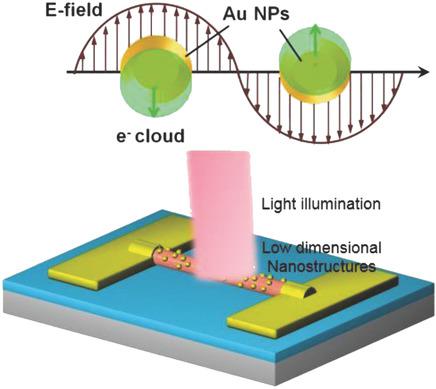当前位置:
X-MOL 学术
›
Adv. Opt. Mater.
›
论文详情
Our official English website, www.x-mol.net, welcomes your feedback! (Note: you will need to create a separate account there.)
Low‐Dimensional Plasmonic Photodetectors: Recent Progress and Future Opportunities
Advanced Optical Materials ( IF 9 ) Pub Date : 2018-02-06 , DOI: 10.1002/adom.201701282 Jian-An Huang 1, 2 , Lin-Bao Luo 1
Advanced Optical Materials ( IF 9 ) Pub Date : 2018-02-06 , DOI: 10.1002/adom.201701282 Jian-An Huang 1, 2 , Lin-Bao Luo 1
Affiliation

|
Plasmonic nanostructures can achieve subdiffraction‐limit light confinement with enhanced electric fields. By taking advantage of the light‐confinement effect, various plasmonic photodetectors that combine low‐dimensional (LD) semiconductor structures and plasmonic materials have recently demonstrated excellent plasmon‐enhanced device performance and attracted significant research interest. In this review, the state‐of‐the‐art progress in the development of various LD photodetectors with different plasmonic structures is briefly surveyed, in order to provide a clear picture of related fabrication methods, leading to maximized plasmonic enhancement. The fundamentals of localized surface‐plasmon resonance and plasmonic hot electrons are first introduced, followed by a summary of several prototypical LD photodetectors enhanced by metal nanoparticles (NPs), including noble‐metal NPs, poor‐metal NPs, and some plasmonic doped‐semiconductor NPs. The recent achievement of the newly developed LD photodetectors propelled by plasmonic hot carriers is also highlighted. Finally, some challenges and issues that need to be resolved in this field are proposed.
中文翻译:

低维等离子光电探测器:最新进展和未来机会
等离子纳米结构可以通过增强电场实现亚衍射极限光限制。通过利用光限制效应,结合了低维(LD)半导体结构和等离激元材料的各种等离激元光电探测器最近表现出出色的等离激元增强的器件性能,并引起了广泛的研究兴趣。在这篇综述中,简要概述了各种具有不同等离激元结构的LD光电探测器在开发中的最新进展,以便提供有关制造方法的清晰图片,从而实现最大程度的等离激元增强。首先介绍了局部表面等离子体共振和等离子体热电子的基本原理,然后总结了几种由金属纳米颗粒(NP)增强的原型LD光电探测器,包括贵金属NP,贫金属NP和一些等离激元掺杂半导体NP。等离子体热载流子推动的新开发的LD光电探测器的最新成就也得到了强调。最后,提出了该领域需要解决的一些挑战和问题。
更新日期:2018-02-06
中文翻译:

低维等离子光电探测器:最新进展和未来机会
等离子纳米结构可以通过增强电场实现亚衍射极限光限制。通过利用光限制效应,结合了低维(LD)半导体结构和等离激元材料的各种等离激元光电探测器最近表现出出色的等离激元增强的器件性能,并引起了广泛的研究兴趣。在这篇综述中,简要概述了各种具有不同等离激元结构的LD光电探测器在开发中的最新进展,以便提供有关制造方法的清晰图片,从而实现最大程度的等离激元增强。首先介绍了局部表面等离子体共振和等离子体热电子的基本原理,然后总结了几种由金属纳米颗粒(NP)增强的原型LD光电探测器,包括贵金属NP,贫金属NP和一些等离激元掺杂半导体NP。等离子体热载流子推动的新开发的LD光电探测器的最新成就也得到了强调。最后,提出了该领域需要解决的一些挑战和问题。



























 京公网安备 11010802027423号
京公网安备 11010802027423号